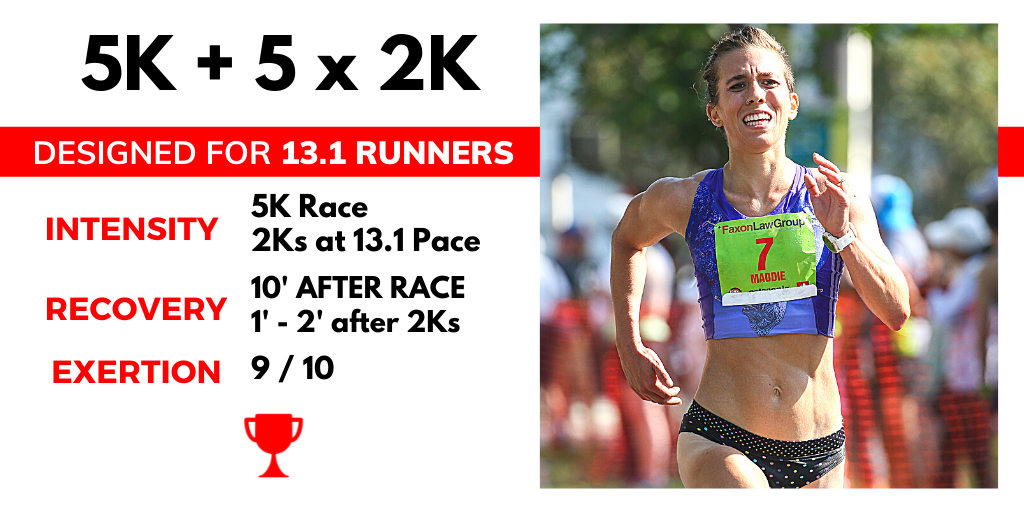5K + 5 x 2K
5K + 5 x 2K
Designed for 13.1 runners
Intensity
5K race at 100% 5K pace
5 x 2K at 13.1 race pace
Recovery
10 minutes after 5K race
1 - 2 minutes between 2K reps
Exertion
9/10
Periodization
Performance Period
Context & Details
One of the dominant performance variables that influence half-marathon success is fatigue resistance.
Several factors influence fatigue resistance: neural governor, stretch-shortening cycle, heat dissipation, and glycogen concentrations.
One way to promote fatigue resistance is to create a “crisis” situation by taxing the brain, increasing core temperature, and depleting glycogen availability.
Enter’s today’s workout — a 5K followed by 5 by 2K reps at half marathon pace on short recovery, and you‘ve got all the ingredients to effectively advance fatigue resistance.
If you want to get better results by learning more about Fatigue Resistance training methods, Join the Running Scholar Program for only $29 and get unlimited access to tons of training logs and courses that show how you can successfully implement Fatigue Resistance training into your training.
Extended training at race speeds coupled with short recovery intervals promotes fatigue resistance. These are important training principles successful coaches like Jerry Schumacher, Renato Canova, Bill Bowerman, and Arthur Lydiard all understand and apply in their training.
Extended periods of training at specific running velocity hike resistance to fatigue at that specific speed. Running economy is enhanced. Confidence in the ability to manage race pace increases. Fueling substrates shift to include a high percentage of lactate and fatty acids, conserving glycogen expenditure.
Shortening recovery periods is an effective strategy for promotion fatigue resistance because it simulates race conditions more closely. Expanding recovery intervals make a race pace training session less specific to competitive situations.
In early training periods, when the target race pace is being introduced, longer recovery intervals are fine. Once a half marathoner is in the Specific and Performance periods, training sessions progress with the intent that race pace work intervals get longer and corresponding recovery intervals shorten.
If you get to the Performance Period and you need to take extensive recovery intervals between race pace reps, then it is a clear signal the athlete is not prepared to handle that pace on race day — and expectations need to be adjusted.
This workout is an excellent half marathon race simulator session, I like to place it one week to two weeks out before a target 13.1 competition. Training surrounding this session should be low-volume and light intensity so the athlete enters into it well-rested and can bounce back quickly (1 - 3 days) from the effort.
Since it involves a 5K race, it’s a fun workout, as the half-marathon runner gets to both compete and practice running hard and fast. It also provides excellent feedback on how the runner handles half marathon pace running in a tiring state and informs how they should plan to race their upcoming half-marathon to maximize their competitive chances.
Any questions? Direct Message me on twitter.
Thx. | jm
Get Better Results with The Running Scholar Program.
Join the Running Scholar Program for $29 to learn more about successful Half Marathon Training and get unlimited access to courses and training programs on Half Marathon running.
3 Good Books on Half Marathon training
The Science of Running by Steve Magness
Running Science by Owen Anderson
Block Periodization by Vladimir Issurin


